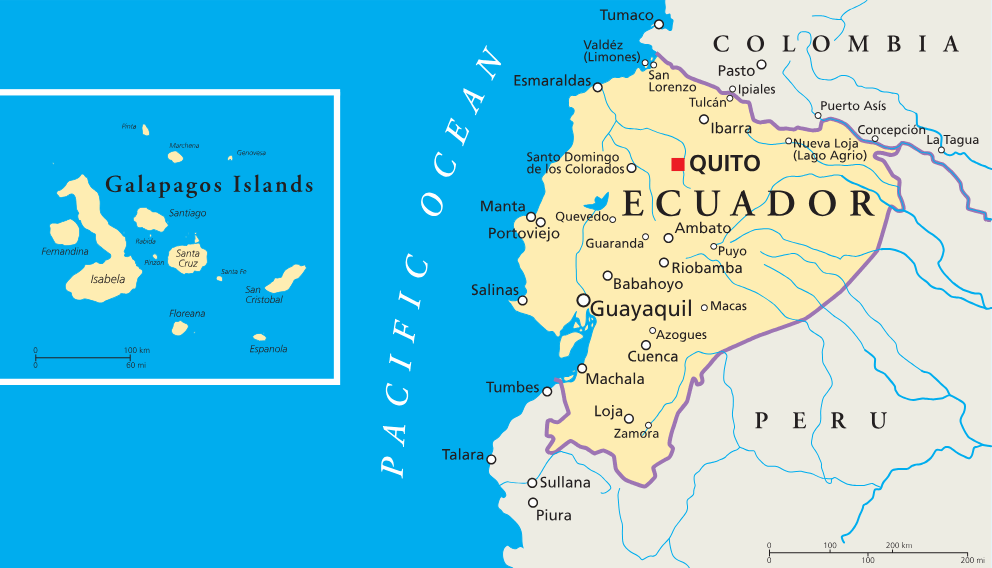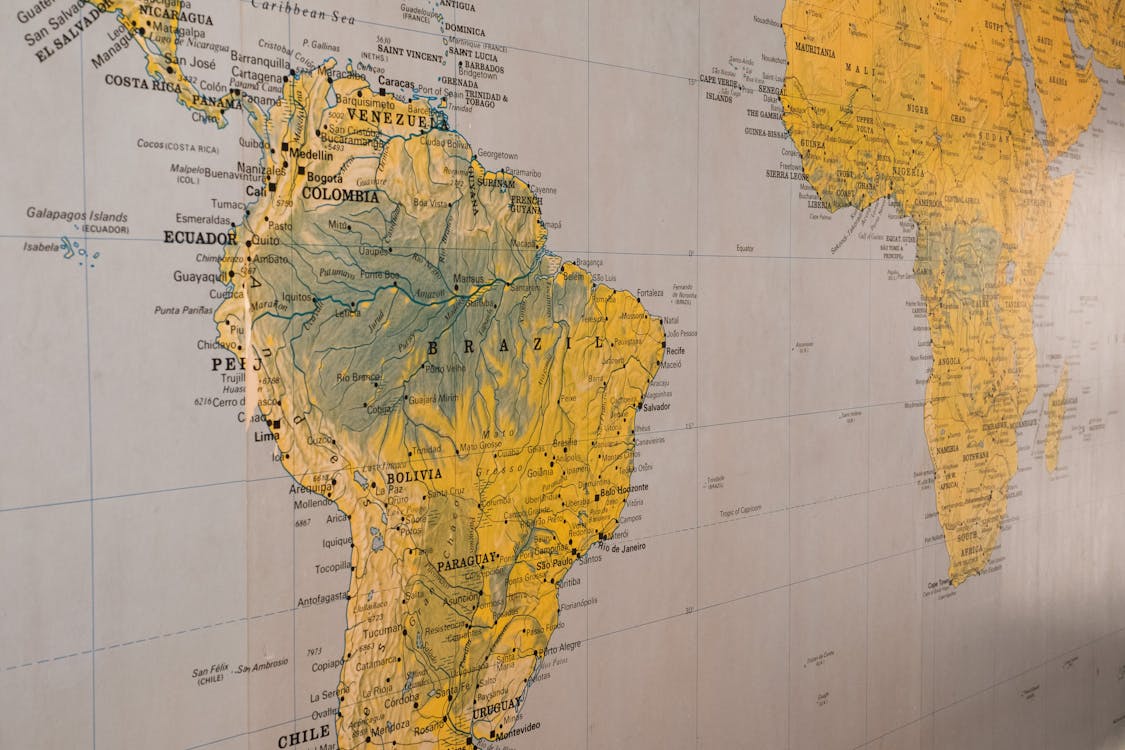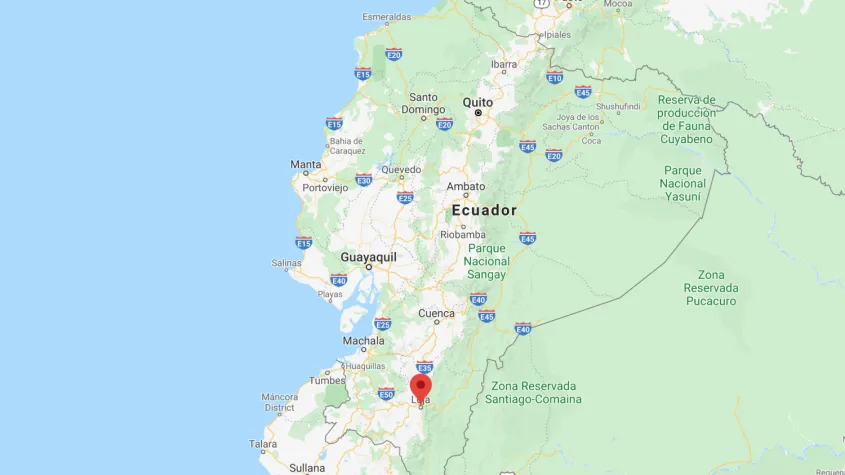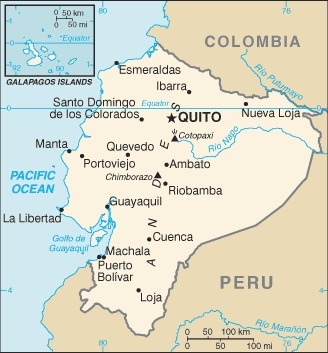Map Of Ecuador - Flag, Capital, Currency, And Fascinating History
Learn about Ecuador’s geography and attractions through our comprehensive map. See the vibrant cities and breathtaking landscapes today.
Author:Finn WildeReviewer:Michael RachalDec 04, 202424.8K Shares516.8K Views

Ecuador, renowned for its stunning landscapes and rich cultural heritage, has a fascinating history. Originally home to indigenous peoples like the Incas and the Shuar, the nation gained independence in 1822 and has since navigated significant political changes and social movements. Its diverse geography, from the Andes mountains to the Amazon rainforest and the Galápagos Islands, captivates travelers and scholars alike.
The map of Ecuadorserves as a gateway to understanding its multifaceted identity. Each bustling city and serene natural park offer insights into the unique cultural and historical aspects that define the nation.
Geographical Overview Of Ecuador
Ecuador is bordered by Colombia to the north, Peru to the south and east, and the Pacific Ocean to the west. The country covers an area of approximately 256,370 square kilometers (98,998 square miles), making it one of the smaller countries in South America, yet incredibly diverse in its geography. One of the best places to travel in Januaryoften include destinationslike Ecuador, where varied landscapes feature coastal plains, mountainous regions, and dense rainforests, creating a rich tapestry of ecosystems that supports an array of wildlife.
The equatorial location of Ecuador ensures a variety of climates and microclimates across its regions, significantly influencing the country’s agriculture, biodiversity, and culture. This geographical diversity is crucial for understanding both the physical and social dynamics of Ecuador.
Capital Of Ecuador
The capital of Ecuador is Quito, located in the central part of the country, in the Andes mountains. Quito is known for its historic center, which is a UNESCO World Heritage Site, and its position at an altitude of 2,850 meters (9,350 feet) above sea level, making it one of the highest capital cities in the world.
Key Features Of Quito:
- Historic Significance: Quito was one of the first cities to be declared a UNESCO World Heritage Site due to its well-preserved colonial architecture and rich history. The city was founded in the 16th century on the site of an ancient Inca city.
- Modern City: Quito is the political, cultural, and economic center of Ecuador. It has a population of approximately 2.8 million people and serves as a hub for government institutions, embassies, and businesses.
- Tourist Attractions: Some of the top attractionsin Quito include Plaza Grande, La Basilica del Voto Nacional, and Mitad del Mundo, which marks the location of the equator.
Map Of Ecuador Cities
1. Quito
Quito, the capital city of Ecuador, is located in the Andean highlands at an altitude of 2,850 meters (9,350 feet). It is renowned for its well-preserved colonial architecture and was the first city to be designated a UNESCO World Heritage Site in 1978.
The historic center is dotted with beautiful plazas, churches, and museums, including the impressive Basilica del Voto Nacional and the ornate La Compañía de Jesús church. Quito also serves as the political and cultural heart of the country, making it a hub for national events and celebrations.
2. Guayaquil
As the largest city in Ecuador, Guayaquil is a vital economic center located on the Guayas River. Known for its modern infrastructure and vibrant waterfront, the city has undergone significant transformation in recent years, making it a bustling metropolis.
The Malecón 2000 is a popular promenade that offers stunning views of the river and is lined with parks, restaurants, and cultural attractions. Guayaquil is also known for its rich culinary scene, showcasing traditional Ecuadorian dishes.
3. Cuenca
Cuenca is famous for its colonial architecture and is often regarded as the cultural capital of Ecuador. The city is a UNESCO World Heritage Site, recognized for its well-preserved historical buildings, charming cobblestone streets, and beautiful plazas.
Cuenca is also known for its artisan markets, where visitors can find traditional handicrafts, including Panama hats and ceramic pottery. The city's location in the Andean highlands offers stunning views of the surrounding mountains and valleys, making it a popular destination for both tourists and expats.
4. Manta
Manta is a coastal city located on the Pacific coast of Ecuador, known for its beautiful beachesand thriving fishing industry. The city is a major port and serves as a hub for trade and commerce. Manta's warm climate and sunny weather make it a popular destination for beachgoers and water sports enthusiasts.
The nearby Isla de la Plata, often referred to as the "Poor Man's Galápagos," is accessible from Manta and offers excellent opportunities for birdwatching and snorkeling.
5. Loja
Loja is known for its rich musical heritage and is often referred to as the "City of Music." Located in the southern part of Ecuador, Loja boasts a vibrant cultural scene, with numerous music festivals and events throughout the year.
The city is also surrounded by stunning natural landscapes, including the Podocarpus National Park, which is home to diverse flora and fauna. Loja's charming architecture and relaxed atmosphere make it a delightful destination for visitors interested in Ecuador's cultural and natural beauty.
6. Ambato
Ambato is situated in the central highlands of Ecuador and is known for its beautiful flower gardens and fruit production. The city hosts the annual Ambato Carnival, a colorful celebration that features parades, music, and traditional dances.
Ambato is also famous for its picturesque landscapes, surrounded by mountains and valleys. The city's rich agricultural heritage is evident in its markets, where visitors can find a variety of fresh fruits and flowers.
7. Machala
Machala is located in the southwestern part of Ecuador, along the coast, and is known as the "Banana Capital of the World." The city plays a crucial role in the country's banana export industry, contributing significantly to Ecuador's economy.
Machala's coastal location provides access to beautiful beachesand seafood, making it a popular destination for both locals and tourists. The city also hosts various festivals celebrating its agricultural heritage.
8. Esmeraldas
Esmeraldas is a coastal city located in the north of Ecuador, known for its Afro-Ecuadorian culture and beautiful beaches. The city features a vibrant music scene, particularly with genres like marimba and salsa, reflecting its rich cultural heritage.
Esmeraldas is also famous for its natural beauty, with stunning beaches such as Playa de Sua and Las Palmas, attracting visitors seeking relaxation and water activities. The surrounding region is rich in biodiversity, with mangroves and tropical forests.
9. Puerto Viejo
Puerto Viejo is a small town located on the southern coast of Ecuador, known for its laid-back atmosphere and beautiful beaches. It is a popular destination for surfing, fishing, and enjoying the natural beauty of the Pacific coast.
The town offers a range of accommodations, restaurants, and local shops, making it an inviting spot for travelers looking for a more relaxed experience. Puerto Viejo is also close to the Machalilla National Park, known for its biodiversity and scenic landscapes.
10. Cayambe
Cayambe is a city located in the highlands of Ecuador, known for its impressive views of the Cayambe volcano, which is the highest point on the equator. The city is famous for its agricultural products, particularly its delicious cheese and the unique "cayambe bread."
Cayambe is also a gateway for hikers and nature enthusiasts looking to explore the surrounding Andean landscapes and the nearby Otavalo market, renowned for its indigenous crafts and textiles.
Regions On The Map Of Ecuador
1. The Andes
The Andes mountains dominate the central region of Ecuador, featuring stunning peaks and valleys. This mountainous region is known for its rich biodiversity, agricultural production, and indigenous communities. Key cities like Quito and Cuenca are located here, offering access to beautiful landscapes and cultural heritage.
2. The Coast
Ecuador's coastal region stretches along the Pacific Ocean, known for its warm climate, beautiful beaches, and significant agricultural production. Major cities like Guayaquil and Manta are key economic centers, with thriving fishing and trade industries. The coast is also popular for tourism, attracting visitors to its picturesque beaches and resorts.
3. The Amazon
The Amazon region of Ecuador is renowned for its incredible biodiversity and unique ecosystems. This area is home to numerous indigenous communities and is rich in wildlife, making it an essential part of Ecuador’s ecological heritage. The Amazon rainforest is a crucial area for conservation and research, attracting eco-tourists and scientists alike.
4. The Galápagos Islands
Located about 1,000 kilometers (620 miles) off the coast, the Galápagos Islands are famous for their unique wildlife and pristine landscapes. The islands are a UNESCO World Heritage Site and are known for their role in Charles Darwin’s theory of evolution. Tourism in the Galápagos focuses on sustainable practices to protect its delicate ecosystems.
Population
Ecuador has a population of approximately 17 million people, making it one of the more populous countries in South America. The population is ethnically diverse, comprising mestizos, indigenous peoples, Afro-Ecuadorians, and European descendants. This cultural diversity is reflected in the languages spoken, with Spanish being the official language, alongside various indigenous languages.
Urban areas, particularly Quito and Guayaquil, experience higher population densities, while rural regions, especially in the Amazon, are less populated. This distribution affects the social dynamics, economic activities, and cultural practices within the country.
Government Of Ecuador
Ecuador is a democratic republic with a presidential system of government. The country operates under a constitution that ensures separation of powers between the executive, legislative, and judicial branches. The President of Ecuador is both the head of state and government and is elected for a four-year term. Ecuador has a unicameral legislature, which is made up of the National Assembly, consisting of 137 members. These members are elected through a proportional representation system.
Ecuador's legal system is based on civil law, and the judiciary operates independently from the executive branch. The country has decentralized administrative divisions, meaning that provinces, cities, and towns have a level of local autonomy. Ecuador is also a member of the United Nations, OAS, and other international organizations, reflecting its active participation in global politics.
Key Government Offices:
- President: The head of government, elected for a four-year term.
- National Assembly: The legislative body of Ecuador, responsible for passing laws.
- Constitutional Court: The highest court that oversees the application of the country’s constitution.
Currency Of Ecuador
The currency of Ecuadoris the United States Dollar (USD), which Ecuador adopted in the year 2000 as a response to severe inflation and the economic crisis. The move to dollarization stabilized the Ecuadorian economy, though it also tied the country to the monetary policy of the United States Federal Reserve.
Key Points:
- Currency: United States Dollar (USD)
- Coins: Ecuador uses both U.S. dollar coins (like pennies, nickels, and dimes) and Ecuadorian-specific coins for smaller denominations.
- Banknotes: Ecuador uses U.S. dollar banknotes in various denominations, such as $1, $5, $10, $20, $50, and $100.
While the U.S. dollar is the official currency, travelers should be aware that Ecuadorian businesses may offer their own local coins for small transactions. The adoption of the dollar has brought stability, but it also limits Ecuador’s ability to control its monetary policy.
Dialing Code Of Ecuador
The dialing code of Ecuadoris +593. This code is used when making international calls to Ecuador from abroad. To call Ecuador, you would dial your international access code, followed by Ecuador’s country code (+593), then the area code (if applicable), and finally the local phone number.
Key Points:
- Quito (capital): +593 2
- Guayaquil (coastal city): +593 4
- Cuenca (highland city): +593 7
- Country Code: +593
- Area Codes: Different regions of Ecuador have specific area codes. For example:
- Mobile Phones: Mobile phone numbers in Ecuador typically start with the prefix 09followed by 8 digits.
Language Of Ecuador
The official language of Ecuador is Spanish, which is spoken by the vast majority of the population. However, Ecuador is a multilingual country with a significant indigenous population that speaks a variety of native languages. These indigenous languages are recognized by the constitution as official languages in their respective territories.
Key Languages Spoken:
- Spanish: The predominant language, used in government, education, and daily life.
- Kichwa: A Quechuan language spoken by indigenous communities in the highlands, particularly in the Sierra region.
- Shuar: Another indigenous language spoken in the Amazon region by the Shuar people.
- Other Indigenous Languages: There are several other languages spoken by smaller indigenous groups, such as Tsáchila, Chachis, and Zaparas.
Language Distribution:
- Urban Areas: In cities like Quito, Guayaquil, and Cuenca, Spanish is the main language.
- Rural and Indigenous Areas: In rural areas, especially in the Andes and the Amazon basin, indigenous languages like Kichwa and Shuar are commonly spoken.
Though Spanish is the official language, many Ecuadorians are bilingual, speaking both Spanish and their native indigenous languages.
Flag Of Ecuador
The flag of Ecuador is a horizontal tricolour of yellow, blue, and red. The flag is divided into three horizontal stripes, with yellow occupying the top half and blue and red occupying the bottom half. At the center of the flag is the Coat of Arms, which represents Ecuador's rich history, diverse geography, and national identity.
Meaning Of The Flag's Colors:
- Yellow: Represents the wealth and fertility of Ecuador’s land.
- Blue: Symbolizes the sky and oceans surrounding the country, as well as the freedomof the Ecuadorian people.
- Red: Stands for the bloodshed during the fight for Ecuador’s independence and the valor of its citizens.
The Coat Of Arms:
- Shield: The Coat of Arms features a depiction of Mount Chimborazo (the highest point in Ecuador), the Guayaquil Port, and a pair of crossed flags. The presence of Chimborazo in the emblem reflects the country's pride in its geographical diversity.
- Animals: The shield also contains a condor (representing freedom) and a ship (symbolizing Ecuador’s trade and maritime connection to the world).
Total Area Of Ecuador
Ecuador's total area of 256,370 square kilometers places it among the smaller nations in South America. Despite its size, Ecuador is home to a vast range of ecosystems, from the arid coastal areas to the lush Amazon rainforest. The country's compactness allows for a remarkable variety of geographical features and climates within a short distance, making it an ideal location for both agriculture and tourism.
Move to a new countrylike Ecuador, and you’ll find that the varying elevations also contribute to its diverse climates. Coastal areas experience a tropical climate, while the highlands can be much cooler, leading to different agricultural practices and lifestyles across the country.
National Parks And Landscapes
1. Cotopaxi National Park
Cotopaxi National Park is home to one of the highest active volcanoes in the world, Cotopaxi, which stands at 5,897 meters (19,347 feet). The park features diverse landscapes, including paramo ecosystems, glacial lakes, and unique wildlife. It is a popular destination for hiking, mountaineering, and enjoying the breathtaking scenery.
2. Yasuni National Park
Yasuni National Park is located in the heart of the Amazon rainforest and is known for its incredible biodiversity. It is home to numerous species of flora and fauna, many of which are endemic. The park is also inhabited by indigenous communities that have preserved their traditional lifestyles. Conservation efforts in Yasuni are vital for protecting this unique environment.
3. Cajas National Park
Cajas National Park is characterized by its high-altitude lakes, rugged terrain, and unique ecosystems. It offers stunning landscapes and numerous hiking trails, making it a popular spot for outdoor enthusiasts. The park is also a crucial area for biodiversity conservation, providing habitat for various species, including several endemic plants.
Major Roads And Desert
1. Pan-American Highway
The Pan-American Highway is a significant route that connects North and South America, passing through Ecuador. This highway facilitates trade and travelacross the continent, linking major cities and regions. It is essential for both domestic and international transport, contributing to Ecuador's economy.
2. The Trans-Ecuadorian Oil Pipeline Road
This important road runs parallel to the Trans-Ecuadorian Oil Pipeline, playing a crucial role in transporting oil from the Amazon region to the Pacific coast. It supports the country's oil industry and provides access to remote areas, highlighting the link between infrastructure and economic activities.
3. The Atacama Desert
While primarily located in Chile, the Atacama Desert's influence extends into northern Ecuador. The high, arid desert region is characterized by its stunning landscapes and unique ecosystems. Much like Russian dessertsoffer a taste of Russia’s rich cultural variety, the Atacama’s unique characteristics provide insight into the diverse climatic zones within Ecuador, even if it’s not among the main attractions.
Ecuador Tourist Attractions Map
The map of Ecuador highlights numerous tourist attractions, showcasing the country's rich natural and cultural heritage. Notable sites include:
- Galápagos Islands: Known for their unique wildlife and natural beauty.
- Cotopaxi National Park: Famous for its active volcano and stunning landscapes.
- Historic Quito: A UNESCO World Heritage site with colonial architecture.
These attractions provide opportunities for adventure, exploration, and cultural experiences, making Ecuador a must-visit destination.
Ecuador Economy
Ecuador's economy is diverse, relying heavily on natural resources. The country is one of the largest exporters of bananas, shrimp, and cacao in the world, contributing significantly to its GDP. Oil production is another crucial industry, providing a substantial portion of the country’s revenue.
Agriculture plays a vital role in the economy, especially in the coastal and highland regions, while tourism has grown in importance, driven by the country’s rich biodiversity and cultural heritage. Understanding the economic landscape is essential for appreciating how it is represented on the map.
Interesting Facts About Ecuador
1. Biodiversity Hotspot: Ecuador is one of the most biodiverse countries in the world, home to thousands of species of plants and animals, many of which are endemic. The Galápagos Islands, a UNESCO World Heritage site, are particularly renowned for their unique wildlife.
2. The Equator: Ecuador gets its name from the Spanish word for "equator." The equator runs through the country, and there are several monuments and attractions, such as the Mitad del Mundo, that mark this geographical landmark.
3. Four Distinct Regions: Ecuador is divided into four main geographical regions: the Andes (mountains), the Amazon rainforest, the Pacific coast, and the Galápagos Islands. Each region has its own unique climate, wildlife, and culture.
4. Cultural Diversity: Ecuador is home to a rich tapestry of cultures, including various indigenous groups, mestizos, and Afro-Ecuadorians. Over 13 indigenous languages are spoken, with Quichua being the most prevalent.
5. Official Language: While Spanish is the official language of Ecuador, many indigenous languages are also recognized and spoken throughout the country, reflecting its cultural diversity.
6. Oil Production: Oil is one of Ecuador's most important industries and is a significant contributor to the country’s economy. Ecuador is a member of the Organization of the Petroleum Exporting Countries (OPEC) but left the organization in 1992 and rejoined in 2007.
7. The Andes Mountains: The Andes run through Ecuador from north to south, featuring some of the highest peaks in the country, including Chimborazo, which, despite being the tallest mountain in Ecuador, is actually the closest point on Earth to the sun due to the Earth's equatorial bulge.
8. Coffee and Cacao: Ecuador is known for its high-quality coffee and cacao production. Ecuadorian chocolate is recognized globally, and the country is one of the top cacao producers, exporting fine-flavor chocolate worldwide.
9. Rich History: Ecuador has a complex history, having been part of the Inca Empire before Spanish colonization in the 16th century. It gained independence in 1822 and has since experienced various political changes and social movements.
10. Galápagos Conservation: The Galápagos Islandsare home to unique species, such as the giant tortoise and marine iguana. The Ecuadorian government has implemented strict conservation measures to protect the islands' ecosystems, which are threatened by invasive species and tourism.
FAQs
What Are The Major Geographical Features Of Ecuador?
Ecuador features diverse landscapes, including the Andes mountains, the Amazon rainforest, coastal plains, and the Galápagos Islands.
How Is Ecuador Divided Politically?
Ecuador is divided into 24 provinces, each with its own capital and local government, contributing to the country’s administrative organization.
What Are The Most Visited Cities In Ecuador?
The most visited cities include Quito, Guayaquil, and Cuenca, each offering unique cultural and historical attractions.
How Does Ecuador’s Geography Influence Its Culture?
Ecuador’s varied geography contributes to its cultural diversity, as different regions host distinct traditions, languages, and lifestyles influenced by their environments.
What Natural Wonders Can Be Found In Ecuador?
Ecuador is home to numerous natural wonders, including the Galápagos Islands, Cotopaxi Volcano, and the Amazon rainforest.
Conclusion
The map of Ecuador reveals more than just geographical boundaries; it showcases the rich cultural heritage and natural wonders that make this country unique. Each city and region tells its own story, reflecting the diverse influences that have shaped the Ecuadorian experience over centuries.
Understanding Ecuador's geographical layout and cultural significance is essential for appreciating its beauty. As the country evolves, preserving its natural and cultural treasures becomes increasingly important.
Jump to
Geographical Overview Of Ecuador
Capital Of Ecuador
Map Of Ecuador Cities
Regions On The Map Of Ecuador
Population
Government Of Ecuador
Currency Of Ecuador
Dialing Code Of Ecuador
Language Of Ecuador
Flag Of Ecuador
Total Area Of Ecuador
National Parks And Landscapes
Major Roads And Desert
Ecuador Tourist Attractions Map
Ecuador Economy
Interesting Facts About Ecuador
FAQs
Conclusion

Finn Wilde
Author
For Finn Wilde, the wilderness is more than just a destination - it’s a way of life. Over the past decade, he has led multiple expeditions in some of the world’s most remote regions, from the icy fjords of Greenland to the rugged trails of Patagonia.
Finn emphasizes sustainability in all of his adventures, helping participants connect with nature while promoting responsible exploration. His expeditions inspire individuals to explore the great outdoors while fostering a deep respect for the environment.

Michael Rachal
Reviewer
Michael Rachal believes that luxury lies in the details. With over 20 years of experience in the luxury travel industry, he has crafted hundreds of bespoke itineraries for clients seeking personalized, unforgettable experiences.
Whether guiding clients through private cultural tours or curating culinary journeys with world-renowned chefs, Michael ensures that each trip is tailored to perfection.
His ability to anticipate needs and exceed expectations has earned him a reputation as a leading expert in luxury travel.
Latest Articles
Popular Articles


